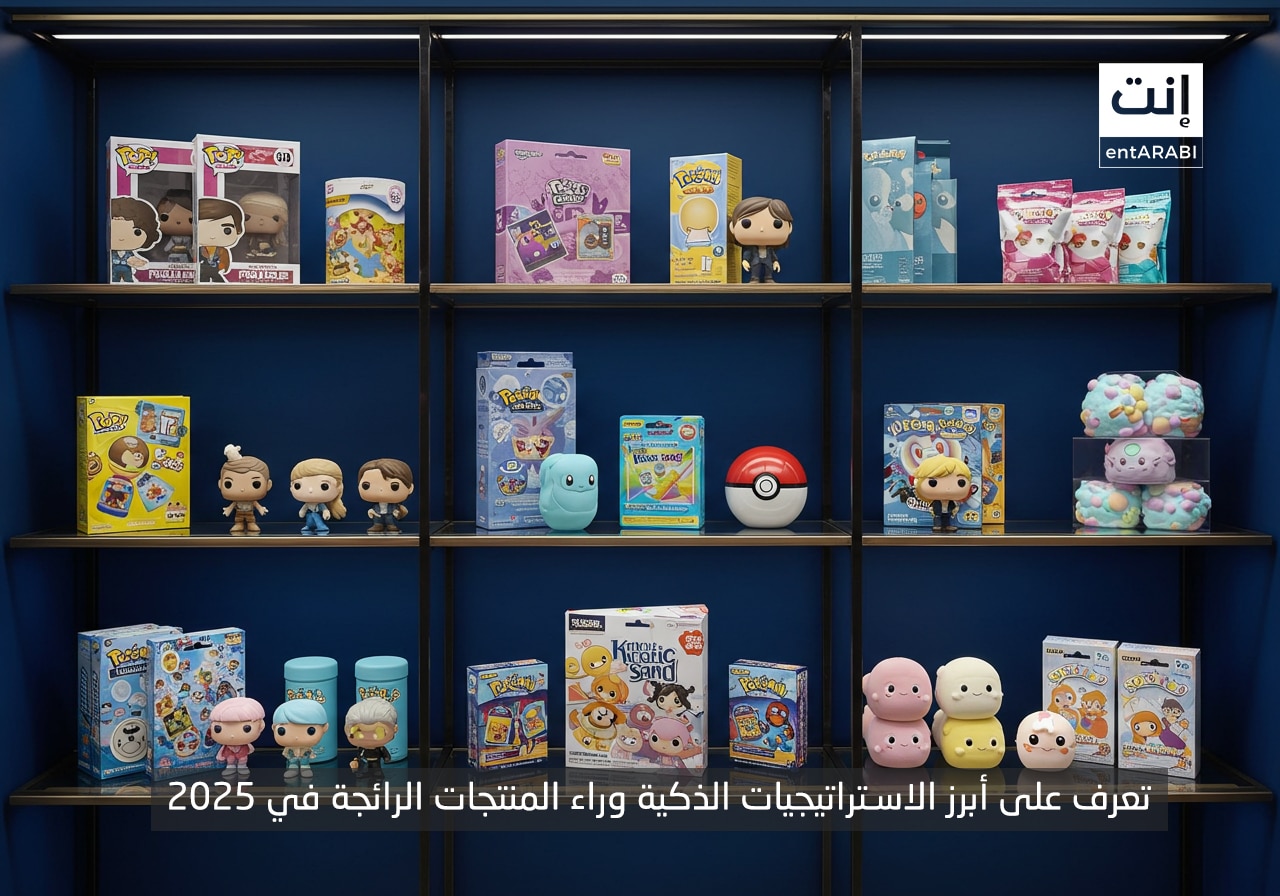This article addresses the daily question for entrepreneurs: “How do I successfully market my product?” They invest effort and capital to promote their products effectively and achieve broad reach among their target audience. Periodically, a new product, toy, or doll emerges, quickly becoming a social media sensation, often without traditional TV ads or large-scale campaigns. These products generate millions in sales and are recognized as trending items, or “trends.”
Do these random successes occur spontaneously? Can any entrepreneur or product creator replicate this success?
In this article, we unveil the top trending products of 2025 and effective online marketing strategies. We analyze the rapid viral spread of products like Labubu, Squishmallows, Pop It, and Fidget Spinner, extracting actionable steps for anyone asking: “How do I successfully market my product?”
Continue reading, as every viral product had a meticulously planned strategy behind it.
What is the Best Way to Market Products Online?
Online product marketing is now the fastest and most impactful method for a product to reach its audience. However, mere promotion is insufficient; you must cultivate curiosity, engagement, and interaction around your product.
Three primary methods have proven successful in marketing products that achieve rapid virality:
1. Focus on the Element of Surprise
Products featuring a “Blind Box” or random surprise concept, such as Labubu, capitalize on consumer curiosity and the desire for repeated purchases to acquire rare editions. This strategy significantly boosts virality, particularly on platforms like TikTok and Instagram.
2. Short, Visual Content is Key
Concise, visual content is fundamental to marketing any new product. Whether it’s an unboxing experience or a simple usage demonstration, these clips provide viewers with an authentic product feel, unlike traditional advertisements. Importantly, these videos often originate from buyers themselves, not just the brand.
When products are showcased by real individuals in spontaneous, unpolished content, immediate trust is established. This User-Generated Content (UGC) not only promotes the product but also builds its credibility, frequently serving as a direct catalyst for purchase decisions.
3. Emotional Connection and Nostalgia Drive Sales
Many successful products sell not just for their utility but for the emotions they evoke. Some companies skillfully leverage nostalgia, reintroducing childhood or adolescent elements, like Pokémon cards. Others, like Squishmallows, offer products that appeal to feeling rather than just appearance, with designs combining simplicity and warmth, and a texture that provides comfort and security.
In both scenarios, the emphasis is not on the product itself but on the emotional impact it leaves. This is precisely where the power of emotional connection as a marketing tool resides.
How to Successfully Market My Product? Marketing Lessons from 2025’s Trending Products
Successful product marketing no longer relies on traditional advertising or vast budgets. Instead, it hinges on a brand’s ability to create genuine experiences, foster emotional connections, and stimulate organic audience engagement.
Products that dominated 2025 offer crucial insights for entrepreneurs, content creators, and marketers seeking widespread reach. Key lessons include:
- Embrace Unconventional Strategies: Pique audience curiosity and encourage participation through novel approaches.
- Leverage User-Generated Content (UGC): Spontaneous UGC builds credibility and expands reach.
- Address Psychological Needs: Successful products often fulfill deep psychological or behavioral needs without overt promotion.
- Design for User Experience: Focus on designs that make users feel integral to the experience, not just consumers.
- Utilize Viral Platforms: Platforms like TikTok are primary drivers of rapid product dissemination.
These principles are universally applicable across various sectors, provided there’s a profound understanding of the audience and an experience designed around their needs.
Case Studies in Viral Product Marketing
Labubu: Viral Success Without Traditional Advertising
Labubu exemplifies how a simple concept can become a global phenomenon. This Chinese doll, created by artist Kasing Lung and sold by Pop Mart, achieved rapid spread not just through its cute design but via a strategic blend of surprise and influencer marketing.
Labubu quickly penetrated Gulf and Asian markets through “Blind Boxes,” where buyers receive a random version. This created anticipation and a desire for rare editions, doubling sales. The company leveraged short video content from influencers unboxing the dolls on TikTok, making Labubu a viral “trend.” Pop Mart also targeted adults, not just children, significantly expanding its customer base.
For more on Pop Mart’s marketing model, see the study: Brand Strategy and the Effective Marketing Position of the Blind Box Industry: A Case Study of Pop Mart
Pokémon Cards: The Power of Nostalgia Marketing
Pokémon cards, originating in the 1990s, experienced a massive resurgence between 2020 and 2024, becoming a top trending product with billions in sales. This success was no accident; the brand expertly used nostalgia.
By targeting millennials who grew up with Pokémon, the company revived memories with a modern twist. Limited-edition sets like Prismatic Evolutions generated immense eagerness, with some fans queuing for hours. Beyond nostalgia, influencer support on YouTube and TikTok, particularly unboxing videos, fueled demand and boosted card market value.
Notably, Pokémon cards integrated entertainment with investment. They became tradable assets, with rare cards fetching thousands of dollars. For instance, a Greninja ex card, valued at $142 in May 2024, reached $280. This price surge attracted investors alongside players and hobbyists, adding a new financial dimension. Track Pokémon card price changes, especially for rare versions exceeding $600, on PriceCharting: https://www.pricecharting.com/game/pokemon-twilight-masquerade/greninja-ex-214
Squishmallows: Emotional Connection and Social Interaction
Squishmallows demonstrate how a simple product can become a global phenomenon through emotional appeal and social interaction. These soft plush toys, with their cute and varied shapes, employed a clever marketing strategy beyond just design.
Each Squishmallow has a unique name and story, fostering a deeper connection and encouraging collecting and trading. Their success stemmed from smart social media use, particularly during the pandemic. Popularity surged on TikTok in 2020-2021 as collectors shared their collections, building an engaged digital community.
Strategic partnerships with major brands like Disney, Hello Kitty, and PUMA further legitimized Squishmallows, appealing to diverse age groups. Surprisingly, a significant portion of their audience comprises young adults and adults, not just children. This expanded market scope led to over 400 million units sold worldwide by August 2024.
The #Squishmallows hashtag garnered over 550 million views initially on TikTok, surpassing 13 billion by May 2024. These figures highlight the product’s widespread reach and the profound emotional connection it forged with its audience—a cornerstone of successful digital-age marketing.
Fidget Spinner: A Product Without a Central Marketing Plan
The Fidget Spinner is a unique case of a product succeeding without a centralized marketing strategy. This simple toy, modestly introduced, became a global sensation in 2017, selling over 50 million units in months, without major corporate advertising.
The secret lay in its simplicity and clear purpose: stress relief and focus for children and teenagers. Its straightforward design and low cost ensured rapid public adoption, making it an “indispensable” item in schools and homes within weeks.
Crucially, its spread was driven by organic content. Thousands of YouTube and TikTok videos featured users showcasing tricks and skills. This interaction transformed the Fidget Spinner from a toy into a social challenge, boosting demand unprecedentedly.
The absence of legal design protection also contributed significantly. Catherine Hettinger’s original patent (US 5591062 A, 1997) lapsed in 2005 due to non-renewal fees. This intellectual property void allowed hundreds of manufacturers worldwide to produce unrestricted versions, ensuring abundance, low prices, and broad accessibility. Its virality was a natural outcome of an open-source product driven by market demand.
Though its popularity has waned, the Fidget Spinner offers a vital lesson: paid marketing isn’t always necessary. Sometimes, clear function, ease of use, and user-generated content are the true drivers of a trend.
Pop It: A Simple Sensory Toy’s Global Rise Without a Marketing Campaign
Pop It stands out among products that succeeded without advertising. This rubber bubble toy, on the market for years, gained fame only in 2020 with the COVID-19 pandemic. As the world sought anxiety and stress relief, especially for children and mothers at home, Pop It emerged as a fun, safe sensory tool.
Remarkably, Pop It spread astonishingly fast on TikTok and short video platforms, without direct brand support. Users shared videos of bubble-popping, contributing to high-view ASMR content, quickly making it a global trend.
Pop It’s simple design allowed manufacturers to create diverse versions—keychains, bags, accessories—in various colors and shapes. This variety expanded its appeal to a wider audience, from children to adults seeking calming products.
The lesson for anyone asking: “How do I successfully market my product?” is clear:
Success isn’t always about paid advertisements, but about a simple design that encourages audience interaction, especially on video-centric social media platforms like TikTok.
Funko Pop: From Simple Toy to $100,000 Collectibles
Funko Pop figures, adopting the Japanese “Chibi” design style (short, cute, large heads, wide-set black eyes), stand out among viral products. This unique aesthetic appealed to all ages.
Since 2010, Funko Pop has linked its products to popular universes like Marvel, Star Wars, and Harry Potter, releasing over 1,000 designs. This fostered a strong collecting and trading community.
A key to Funko Pop’s success is the secondary market for rare items. Limited editions are treated as rare assets, selling for exorbitant prices, sometimes hundreds of thousands of dollars. Top-value versions include:
| Version Name | Estimated Value |
|---|---|
| Golden Ticket 2-Pack | $100,000 |
| Clockwork Orange | $60,000 |
| Freddy Funko Metallic Iron Man | $43,000 |
| Freddy Funko Metallic Ghost Rider | $23,000 |
| Freddy Funko Buzz Lightyear | $24,000 |
| Boo Berry | $20,000 |
| Freddy Funko (Bloody) as Jaime Lannister | $19,000 |
| Freddy Funko as Venom | $19,000 |
| Freddy Funko as The Joker | $13,000 |
| Dumbo | $8,400 |
| Ken Griffey Jr. (Gold) | $8,100 |
| Freddy Funko as Stan Lee | $4,700 |
For those asking “How do I successfully market my product?” Funko Pop offers a complete model: connect your product to popular culture and give your audience a reason to cherish and even invest in what you sell.
Tamagotchi: Meeting a Psychological Need with a Simple Digital Toy
Tamagotchi, launched in Japan in 1996 by Bandai, revolutionized digital games. This virtual pet, housed in an egg-shaped device with an LCD screen and simple buttons, achieved overwhelming global success through clever design and marketing.
Bandai’s pre-launch market research among high school students ensured a locally appealing design. However, its true success lay in fulfilling an emotional need. Psychological studies revealed Tamagotchi filled an “emotional void” for urban dwellers unable to own real pets. This highlights how a product succeeds by aligning with an unstated psychological market need.
Unlike other digital games, Tamagotchi relied on simple behavioral simulation, not complex graphics, creating a strong emotional bond. Users could feed, discipline, medicate, or even neglect their virtual pet, leading to its demise. This experience fostered deep user engagement.
Tamagotchi also broke gender barriers in gaming, with attractive colors, shapes, and gameplay appealing to both boys and girls. When expanding to Western markets, Bandai adapted the product to new cultures, studying psychological differences between collective (Japan) and individualistic (America) societies. They modified design, color, and name while preserving the product’s essence, boosting global acceptance.
Throughout Tamagotchi’s development, Bandai understood that success comes not just from design or technology, but from a deep understanding of audience behavior and psychological needs. They created a seemingly simple product that resonated emotionally and filled a real void.
For entrepreneurs asking: “How do I successfully market my product?” the answer begins not with advertising, but with building a product that resonates with people, addresses their needs, and provides a personal reason to keep it.
Kinetic Sand: A Sensory Product’s Global Trend
Kinetic Sand, initially a children’s product, transcended play to become a sensory tool for stress reduction and sensory stimulation. It quickly became viral visual content on TikTok, Instagram, and YouTube.
Its power lies in its unique texture and immediate impact on the nervous system. Users describe interaction as “satisfying” and “calming.” Behavioral studies support that such sensory stimuli regulate mood and attention, especially for those with hyperactivity or anxiety.
As reported by The News Minute, Kinetic Sand videos elicit a neurological response similar to meditation or relaxation, explaining its immense popularity among ASMR content enthusiasts.
Manufacturers didn’t rely on traditional advertising; the experience spoke for itself. Videos of cutting, pressing, and shaping spread organically, with the audience creating their own content. This indirect marketing allowed Kinetic Sand to permeate homes, schools, and clubs, becoming a sensory, entertaining, and therapeutic product.
How to Successfully Market My Product? Let the Product Speak for Itself
Sometimes the message is in attractive design, sometimes in the feeling it creates, or in the memories it revives, or simply in being enjoyable to watch and experience. When a product achieves one of these, it no longer needs advertising; everyone who uses, watches, or discusses it unknowingly becomes a brand ambassador.
العربية (Arabic) To read the article in Arabic, click here






